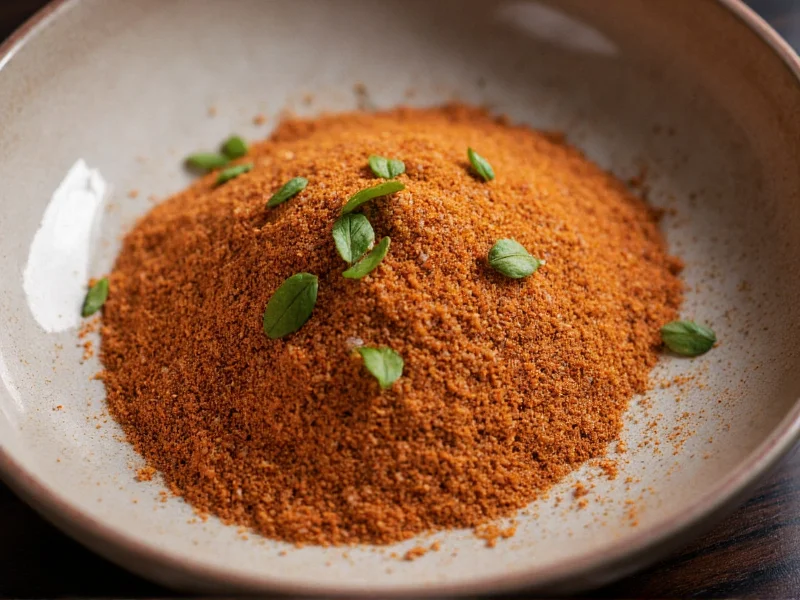Understanding what umami seasoning is requires exploring both its scientific basis and culinary applications. This comprehensive guide explains everything you need to know about this powerful flavor enhancer that's transforming home cooking and professional kitchens alike.
The Science Behind Umami: More Than Just a Seasoning
Umami, recognized as the fifth basic taste alongside sweet, sour, salty, and bitter, was first identified in 1908 by Japanese chemist Kikunae Ikeda. The term "umami" translates to "pleasant savory taste" in Japanese. Scientifically, umami represents our taste receptors' response to glutamate and certain nucleotides that occur naturally in many foods.
When you use umami seasoning, you're essentially concentrating these naturally occurring compounds to enhance the savory profile of your dishes. The human tongue has specific receptors (T1R1 and T1R3) that detect glutamate, creating that satisfying mouthfeel and depth of flavor associated with umami-rich foods like aged cheeses, tomatoes, and meats.
What Exactly Is in Umami Seasoning?
Authentic umami seasoning contains no artificial ingredients. Instead, it combines natural food sources high in glutamate and inosinate/guanilate compounds that work synergistically to create that signature savory boost. Common ingredients include:
| Primary Ingredient | Glutamate Content | Common Forms in Seasonings |
|---|---|---|
| Dried Shiitake Mushrooms | High (0.3-1.2g/100g) | Powdered, flaked |
| Kombu (Kelp) Seaweed | Moderate-High (0.1-0.5g/100g) | Dried strips, powder |
| Fermented Soy Products | Variable | Miso powder, soy sauce powder |
| Tomato Powder | Moderate (0.1-0.3g/100g) | Dehydrated powder |
| Nutritional Yeast | Moderate | Flakes, powder |
Unlike artificial MSG, natural umami seasonings provide these compounds alongside other beneficial nutrients and complex flavor compounds that create a more rounded taste experience. The best umami seasonings blend multiple ingredients to leverage the synergistic effect where glutamate and nucleotides multiply each other's flavor impact.
Umami Seasoning vs. MSG: Clearing Up Confusion
One of the most common questions about what umami seasoning is involves its relationship to MSG. While both deliver umami taste, they're fundamentally different:
- MSG (Monosodium Glutamate): A purified, single-compound additive created through fermentation, consisting of sodium and glutamate
- Natural Umami Seasoning: A blend of whole food ingredients naturally containing glutamate and umami-enhancing compounds
Research shows that while some people report sensitivity to pure MSG, the same reactions are extremely rare with natural umami seasonings containing equivalent glutamate levels. This suggests that other compounds in whole foods may modulate how our bodies process glutamate.
When exploring what is umami seasoning made of, you'll find quality products avoid the "umami = MSG" misconception by using transparent labeling and natural ingredients only. The difference between umami seasoning and MSG comes down to processing and additional compounds present in whole food sources.
Practical Applications: How to Use Umami Seasoning
Understanding what umami seasoning is means knowing how to use it effectively. Unlike salt which primarily enhances existing flavors, umami seasoning actually creates new flavor dimensions in your cooking. Here's how to incorporate it:
Culinary Uses for Umami Seasoning
- Soups and stews: Add 1/4-1/2 teaspoon per serving during final seasoning
- Vegetable dishes: Sprinkle on roasted vegetables before cooking
- Meat preparation: Use as part of dry rubs for enhanced savory notes
- Sauces and gravies: Incorporate during reduction for deeper flavor
- Vegetarian/vegan cooking: Compensate for lack of meat-derived umami
The beauty of natural umami seasoning is its versatility. When learning how to use umami seasoning in cooking, remember it works best when added toward the end of cooking to preserve its delicate flavor compounds. Start with small amounts (1/4 teaspoon per serving) and adjust to taste, as it's possible to overdo umami just like salt.
Creating Your Own Umami Seasoning
One of the best ways to understand what umami seasoning is involves making your own. This homemade version lets you control ingredients and customize flavors to your preference:
Basic Homemade Umami Seasoning Recipe
- 1/4 cup dried shiitake mushrooms, finely ground
- 2 tablespoons kombu seaweed, crumbled
- 2 tablespoons nutritional yeast
- 1 tablespoon tomato powder
- 1 teaspoon dried porcini mushroom powder (optional)
Combine all ingredients in a spice grinder or mortar and pestle until fine. Store in an airtight container away from light. This natural umami seasoning blend will keep for 3-4 months. For those seeking a homemade umami seasoning recipe without mushrooms, substitute additional kombu and tomato powder.
Health Considerations of Umami Seasoning
When exploring is umami seasoning healthy, research indicates several potential benefits:
- Natural umami seasonings typically contain less sodium than MSG while providing similar flavor enhancement
- Many umami-rich ingredients provide additional nutrients (mushrooms offer B vitamins, seaweed provides minerals)
- Umami can help reduce overall sodium needs in dishes by enhancing savory perception
- Unlike processed MSG, natural umami seasonings don't contain processing byproducts
For those monitoring sodium intake, natural umami seasoning can be a valuable tool. Studies show that adding umami compounds allows for 10-20% sodium reduction while maintaining perceived saltiness. This makes understanding what umami seasoning is particularly valuable for health-conscious cooks.
Choosing Quality Umami Seasoning Products
When shopping for umami seasoning, look for these characteristics to ensure you're getting a quality product:
- Transparent ingredient list with recognizable whole food sources
- No added MSG, artificial flavors, or preservatives
- Balanced blend of glutamate and nucleotide sources
- Appropriate sodium levels (check nutrition labels)
- Reputable manufacturer with clear production practices
The best umami seasoning for soups and other liquid-based dishes often includes more water-soluble ingredients like kombu, while blends with mushroom powders work better for dry rubs and vegetable dishes. Understanding these nuances helps you select the right product for your specific culinary needs.











 浙公网安备
33010002000092号
浙公网安备
33010002000092号 浙B2-20120091-4
浙B2-20120091-4